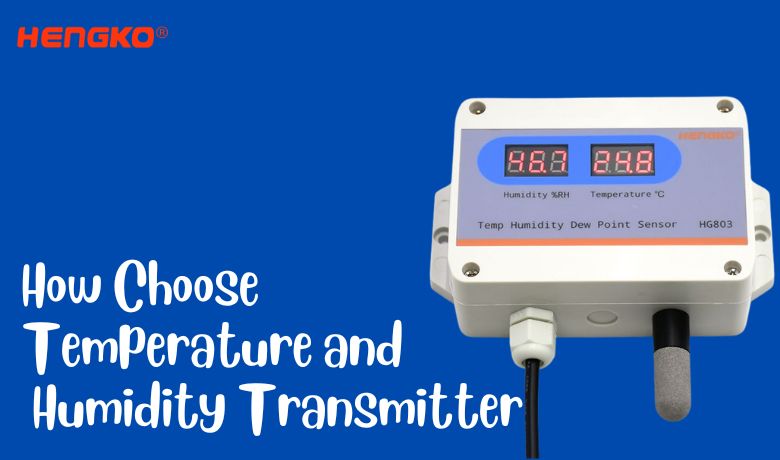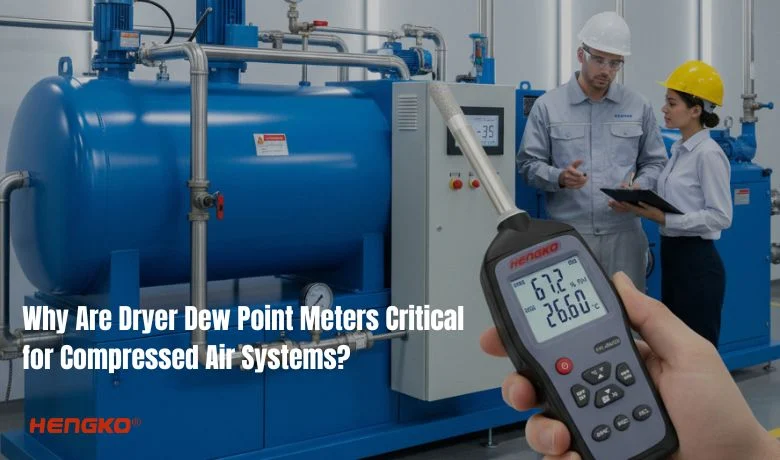To Monitor Temperature and Humidity become more and more important for dialy life and Industry Application.
Then Maintaining the proper temperature and humidity is crucial in a variety of settings, from ensuring human comfort in homes and offices to preserving delicate inventory in warehouses and archives. Improper temperature and humidity levels can lead to a number of problems, including:
- Mold growth
- Pest infestations
- Material degradation
- Discomfort and respiratory problems
Enter the Transmitter:
A temperature and humidity transmitter is a device that electronically measures and transmits these environmental conditions. These transmitters come in a variety of shapes and sizes, with features ranging from basic displays to wireless data transmission for remote monitoring.
Taking Charge of the Environment:
By constantly monitoring temperature and humidity, transmitters allow for implementation of control systems. For example, a transmitter in a greenhouse can trigger automatic adjustments to ventilation or irrigation systems to maintain optimal conditions for plant growth. Similarly, a transmitter in a data center can signal the need for increased air conditioning to prevent overheating of sensitive equipment.
In short, temperature and humidity transmitters are essential tools for maintaining a stable and controlled environment in a wide range of applications.
Understanding Some Basics Definition
Temperature and Humidity on the Move:
- Definition: A temperature and humidity transmitter is an electronic device that continuously measures and transmits these environmental factors.
- Functionality: These transmitters consist of sensors that detect temperature and humidity. The collected data is converted into an electrical signal and then transmitted using various methods like wires or wireless signals. The transmission format can be analog (e.g. 4-20mA current) or digital (e.g. Modbus protocol).
Importance in Key Industries:
- Pharmaceuticals: Precise temperature and humidity control is critical throughout the pharmaceutical lifecycle, from drug manufacturing and storage to transportation. Fluctuations can affect the stability, potency, and efficacy of medications. Transmitters ensure conditions remain within strict guidelines set by regulatory agencies.
- Food Processing: Maintaining proper temperature and humidity is essential for food safety and quality. In food manufacturing facilities, transmitters help prevent bacteria growth, extend shelf life, and ensure consistent taste and texture of products.
- Συστήματα HVAC: Heating, Ventilation, and Air Conditioning (HVAC) systems rely on transmitters to monitor environmental conditions within buildings. This data is used to automatically adjust heating, cooling, and ventilation equipment, resulting in optimal comfort levels and energy efficiency.
By providing real-time data, temperature and humidity transmitters allow for continuous monitoring and intervention to maintain critical environmental conditions across various industries.

Key Factors to Consider You Should Care
Selecting the right temperature and humidity transmitter requires careful consideration of several factors to ensure optimal performance in your specific application. Here’s a breakdown of some key elements:
Accuracy: The Numbers Matter
- Importance: Accurate readings are paramount. Inaccurate data can lead to improper environmental control, potentially causing product spoilage, equipment malfunction, or discomfort for occupants.
- Factors Affecting Accuracy: Sensor quality, calibration routine, and environmental conditions can all influence accuracy. Choose transmitters with high-quality sensors and factor in potential interferences like dust or extreme temperatures.
Measurement Range: Choosing the Right Scale
- Determining the Range: The required measurement range depends on the environment you’re monitoring. For example, a greenhouse might need a wider humidity range (20%-90%) compared to a server room (40%-60%). Selecting a transmitter with a suitable range ensures it can capture the full spectrum of relevant data.
Calibration: Maintaining Precision
- The Need for Calibration: Over time, sensor performance can drift, affecting accuracy. Regular calibration using certified equipment ensures readings remain reliable. Consider transmitters with easy-to-access calibration features and follow the manufacturer’s recommended calibration intervals.
Output Signal Type: Speaking the Same Language
- Αναλογικό έναντι ψηφιακού: Transmitters offer either analog (e.g., 4-20mA current) or digital (e.g., Modbus protocol) outputs. Analog outputs are simpler but offer limited data. Digital outputs provide richer data but require compatible data acquisition systems. Choose the output type based on your existing monitoring infrastructure.
Environmental Conditions: Location, Location, Location
- Considering the Environment: The surrounding environment can impact transmitter performance. For corrosive environments, select transmitters with appropriate housing materials. Outdoor applications might require weatherproof units, while indoor applications might prioritize aesthetics.
Power Requirements: Plugged In or On the Go
- Battery vs. Mains Power: Transmitters can be battery-powered or mains-powered. Battery-powered options offer flexibility for remote locations but require periodic battery changes. Mains-powered transmitters are more reliable but limited by cable length. Consider accessibility to power sources and maintenance requirements when making your choice.
Additional Features to Consider
Beyond the core functionalities, several additional features can enhance the usefulness and effectiveness of your temperature and humidity transmitter. Here are some important considerations:
Data Logging Capabilities: Remembering the Past
- Benefits of Data Logging: Transmitters with built-in data logging capabilities can store readings at programmed intervals. This historical data allows for trend analysis, identification of potential issues, and verification of environmental control effectiveness.
Connectivity Options: Wired vs. Wireless and the Network
- Ενσύρματο vs. Ασύρματο: Transmitters can be wired directly to a monitoring system or utilize wireless technologies like Wi-Fi or Bluetooth. Wired connections offer a reliable data transfer but limit placement flexibility. Wireless options provide greater freedom but might be susceptible to interference. Consider the trade-off between convenience and data security based on your needs.
- Network Integration: For large-scale monitoring applications, transmitters that seamlessly integrate with building management systems or cloud-based platforms are desirable. This allows for centralized data collection, visualization, and analysis from multiple locations.
Ease of Installation and Maintenance: Keeping it Simple
- Simplified Installation and Maintenance: Features like self-explanatory interfaces, easy-to-access calibration ports, and clear user manuals can significantly reduce installation and maintenance time and costs.
Certifications and Standards Compliance: Meeting the Requirements
- Importance of Compliance: In certain industries like food processing and pharmaceuticals, transmitters need to comply with specific industry standards and regulations (e.g., HACCP, FDA). Ensure your chosen transmitter possesses the necessary certifications to meet compliance requirements.
By carefully considering these additional features alongside the core functionalities discussed in Part 2, you can select a temperature and humidity transmitter that perfectly matches the needs of your specific application.
Steps List to Choose the Right Transmitter
Selecting the ideal temperature and humidity transmitter requires a well-defined approach. Here’s a step-by-step guide to navigate the process:
1. Assess Your Needs:
- Clearly define the purpose of the transmitter. What environmental conditions are you monitoring?
- Consider the desired level of accuracy and measurement range.
- Identify the output signal type compatible with your existing monitoring system.
- Evaluate environmental factors like temperature extremes, humidity levels, or potential for corrosion.
- Determine power availability (mains or battery) at the installation location.
2. Research and Shortlist:
- Conduct online research to identify transmitter options that meet your initial criteria.
- Explore manufacturer websites, product brochures, and specification sheets.
- Consider consulting with distributors or industry professionals for recommendations.
3. Compare Key Features:
- Create a comparison table listing shortlisted transmitters and their specifications.
- Evaluate factors like accuracy, measurement range, output type, environmental ratings, power requirements, data logging capabilities, connectivity options, and ease of use.
- Prioritize features based on their importance to your specific application.
4. Consider Future Proofing:
- Think about potential future needs. Will your monitoring requirements expand?
- Choose a transmitter with scalability in mind, offering features that can accommodate growth.
5. Read Reviews and Case Studies:
- Look for online reviews and user testimonials on shortlisted transmitters.
- Explore case studies that showcase similar applications to yours.
- Gain insights into real-world performance and user experiences.
6. Contact Manufacturers for Advice:
- Don’t hesitate to contact transmitter manufacturers directly.
- Discuss your specific needs and application details with their technical support teams.
- Seek personalized advice and recommendations based on your unique requirements.
By above steps and carefully considering the factors outlined in the previous sections, you’ll easy to choose the right temperature and humidity transmitter that perfectly fits your industry monitor needs and ensures optimal environmental monitoring within your application.
Let's Conclusion
Selecting the right temperature and humidity transmitter is not just a matter of preference;
it’s a crucial decision that significantly impacts the success of monitoring projects across various industries.
The precision, reliability, and functionality of your chosen transmitter directly affect the accuracy of environmental monitoring, which can have profound implications for product quality, safety, and regulatory compliance. Given the wide range of options available in the market, understanding the specific needs of your project, from environmental conditions to data logging capabilities, is essential.
Equally important is the consideration of future scalability and the potential need for integration with other monitoring systems. Making an informed choice ensures not only the effectiveness of your monitoring setup but also its efficiency and sustainability over time.
If you have any questions or need further guidance on Select The Right Temperature And Humidity Transmitter . do not hesitate to reach out.
HENGKOmeter is dedicated to providing you with the expertise and support needed to make the best decision for your monitoring projects.
Contact us via email by sales@hengkometer.com, and let us assist you in ensuring your project’s success with the perfect temperature and humidity monitoring solution.
Your peace of mind and project success are our top priorities.





